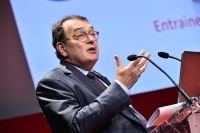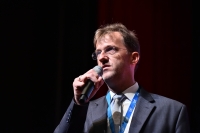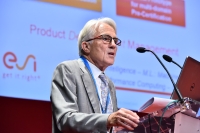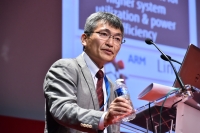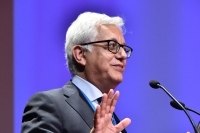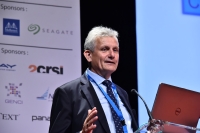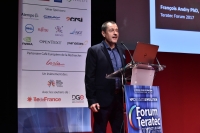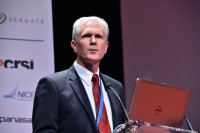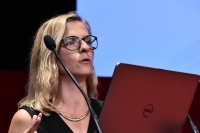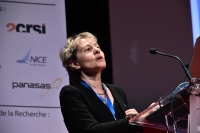 |
||
Gérard Roucairol, Président de Teratec
Norbert LUETKE-ENTRUP, Head of Technology and Innovation Management, SIEMENS
Alain DE ROUVRAY, Président Directeur Général, ESI-GROUP
Toshiyuki SHIMIZU , Vice President of the System Development Division, Next Generation Technical Computing Unit, FUJITSU
Khalil ROUHANA, Directeur-Général Adjoint in DG CONNECT, COMMISSION EUROPEENNE
Franck GARNIER, Président du Directoire, BAYER SAS
Francois ANDRY, Sr. Director, Enterprise Architecture, PHILIPS Healthcare
Jay D HUMPHREY, John C. Malone Professor of Biomedical Engineering, YALE
Adeline LOISON, Directrice Générale Déléguée Analytique, Groupe HLi
Catherine LAMBERT, Directrice du CERFACS
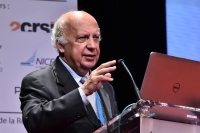
Hervé MOUREN, Directeur de TERATEC
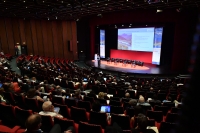
Home > TERATEC FORUM > Program
TERATEC 2017 Forum
Plenary sessions
Tuesday, June 27, 2017
Technological challenges and diversification of big data and simulation applications
The 2017 Forum has been a huge success, with the leading innovators in R&D and industry coming to explain to over 1,300 attendees how Big Data, Simulation and HPC can enable them to embrace the great digital transition underway. It also provided an opportunity for European public authorities to confirm their support for HPC, with the announcement of funding to purchase two exaflop supercomputers which will be made available to researchers and manufacturers across Europe by 2023.
Once again, the entire HPC ecosystem turned out in force for this, the 12th Teratec Forum, held on June 27 and 28 at the prestigious Ecole Polytechnique. "With over 1,300 attendees, 90 international speakers and over 70 exhibitors, the Teratec Forum has carved itself a reputation as THE European event in the field of HPC," as Gérard Roucairol, Chairman of Teratec, proudly said, before focusing on how the use of HPC is currently revolutionizing the ways in which we think of system performance.
"Just a few years ago, you had to analyze the laws of physics governing a system in order to create an exact model that could be used with multiple data sets to predict how it would behave using HPC. Now, gathering and analyzing ‘‘Big Data’’ from the system allows you to create predictive statistical models, which may soon be replaced by neural networks trained by HPC, which will create models themselves and deduce how systems will perform in the future. These advances will be used together to speed up the development of innovative products and services. Thanks to HPC, computing will become predictive and prescriptive in all sectors of society."
Another future application of HPC is ‘‘Blockchain’’, destined to play the role of democratic hardware intermediaries and mediators, and for which HPC will be used to authenticate the digital identity of everyone who wants to use these intermediaries and mediators.
HPC is reinventing industrial manufacturers' core trades
Norbert Luetke-Entrup, Head of Technology and Innovation Management at Siemens, then took the stand to demonstrate how digital science is revolutionizing the core trades of one of the world leaders in the electrics industry. "Just as today, we don't go out and buy CDs any more but stream the music we want to listen to, the industry no longer manually programs pre-installed production machines, but rather optimizes how they function from the design stage using digital behavior models. In a similar vein, the use of digital twins of industrial production systems, fed data from thousands of connected sensors on the actual systems, are used for enhanced predictive maintenance."
Combining Industrial IoT (Industrial Internet of Things) with analysis of ‘‘Big Data’’ will revolutionize many industries, from energy production to optimizing processing equipment and medical procedures, by enabling the many components of a system to dialog in real time to optimize their individual performance, and thereby make them more efficient and more robust overall. "We have already set up such innovative systems on Renfe high-speed trains (on Spain's rail network) as well as on the Cern's Large Hadron Collider to improve availability. We have also equipped electricity plant gas turbines with ‘‘learning systems’’ to reduce NOx emissions by 15 to 20%." This approach may, in time, lead to equipment suppliers developing new services for users.
It is also self-evident, according to Alain de Rouvray, Chairman and CEO of ESI-Group, who, as a supplier of simulation solutions, explained how industrial manufacturers are moving on from immersive virtual engineering to hybrid twins to optimize product performance through the full lifecycle, which he described as the transition from PLM (Product Lifecycle Management) to PPL (Product Performance Lifecycle).
This transition will come about by switching from virtual digital prototypes used to simulate physical effects in order to certify products prior to developing real prototypes, to a digital hybrid twin which, thanks to data feedback from the system via the Internet of Things (IoT) and Artificial Intelligence (AI) techniques, Machine Learning (ML) and Deep Learning (DL), will be able to self-adapt in real time to new conditions, and thereby improve performance. "This implies a switch from a good product to an efficient and sustainable solution as demanded by users."
Computer evolution
To achieve such results, computers also need to evolve. This was the subject of the talk given by Toshiyuki Shimizu, Vice President of the System Development Division, Next Generation Technical Computing Unit at Fujitsu. The Japanese firm has been making supercomputers for over 40 years, increasing their power from 33 megaflops to over 10 petaflops in the case of its K-Computer. In a bid to take this even further, Fujitsu is now pursuing its partnership with the RIKEN Institute to develop the Post-K computer. "Our goal is to build a computer that has high application performance, low energy consumption and upward application compatibility, as well as being simple to access and extremely user-friendly. To this end, we have opted for a proprietary CPU compatible with ARM architecture and a new type of data, FP16, which is more energy-efficient."
EU support
In Europe, the public authorities are well aware of the scale and potential of these advances, as explained by Khalil Rouhana, Deputy Director-General of the European Commission DG Connect. "The European Commission has stated its desire to make Europe one of the world's three centers of excellence in HPC by 2020, at the Digital Day held in Rome in March, on the fringes of the ceremonies celebrating the 60th anniversary of the Treaty of Rome."
This is reflected in EuroHPC, an initiative that brings together several Member States (Germany, Spain, France, Italy, Luxembourg, the Netherlands and Portugal) to build and deploy exascale computing infrastructure, which will be made available to the scientific community as well as public- and private-sector partners across Europe. Two exascale computers will be purchased and brought into service in around 2022-2023.
HPC is good for your health
To illustrate what HPC can do for industry players, the afternoon's speakers described some of the advances made in the field of healthcare. First Frank Garnier, President of Bayer SAS, said that he believes HPC has brought about four major transformations within the Bayer Group: It has opened up new fields of innovation in the Life Sciences thanks to ‘‘Big Data’’; it has accelerated the development of Product-Services combinations; it has led to the development of new approaches (personalized healthcare, the Economy of Functionality); and it may reconcile society with applied chemistry in pharmaceuticals and agriculture.
"This has been a real revolution as far as we are concerned, because, since the Earth came into being some 4.6 billion years ago, we have had the same box of chemical tools to work with (DNA, RNA and proteins), but, in the last few years, digital technology has changed everything. Thus, DNA sequencing, which took 15 years to achieve and cost 2.7 billion dollars in 1990, can now be done in 2 hours and costs less than 1,000 dollars! This is an amazing advance, if you think about the fact that the bacteria in our intestines, which regulate many of our physiological processes, contain 150 times more genes than the human genome."
It is therefore to be hoped that digital simulation techniques will help reduce the cycle and the cost of developing new drugs. This is vital since it takes 10 to 12 years to develop a new drug, and costs nearly 300 million euros to put a new drug on the market, after synthesizing and testing upwards of 160,000. Similarly, analyzing ‘‘Big Data’’ from microscopy imaging will speed up drug phenotyping. The same goes for analyzing cell behavior using 3D fluorescence microscopy images. In agriculture, satellite images of plots of land are analyzed to detect deficiencies and disease in plants and then treat each m² with the exact dose of fertilizer and phytosanitary treatments required. Human healthcare is no exception, with the emergence of much more effective personalized medical treatment.
This was also demonstrated by Jay D Humphrey, Professor of Biomedical Engineering at Yale University, for whom digital technology can be used to effectively treat one of the major causes of death, cardio-vascular disease. "In the case of the formation of thrombosis that can lead to a ruptured aneurism, MRI images are processed to recreate a digital model of a person's blood circulatory system in which blood flow is simulated using fluid mechanics equations. This is a real challenge for HPC because simulating five heartbeats requires mesh elements with 5x106 degrees of freedom, 104 time steps and 5x103 hours of CPU time, which generates no less than 50 Gb of data! However, this helps us to understand how these cardio-vascular diseases progress so that we can evaluate the risks for the patient."
Last, Francois Andry, Senior Director, Enterprise Architecture, at Philips Healthcare, demonstrated how the Cloud has served to set up a platform to facilitate high-performance medical data processing. This is a massive problem, since there are no fewer than 190 million patients, in more than 100 countries, who are tracked every year by Philips monitoring devices, generating 10 petabytes of data! "Processing all this data enables scientists to develop much more effective personalized treatment, factoring in genomic heterogeneity of individual people."
Facilitating innovation
Rounding up the day's plenary sessions, Hervé Mouren, Managing Director of Teratec, focused on promoting SMEs to show that HPC is not just for large industrial groups.
Adeline Loison and Alassane Cisse, Directors of HLi consultants who provide support to companies for digital transition, explained how they assist their customers to use Machine Learning to manage their strategy and take operational decisions, based on heterogeneous data which at first sight appears meaningless. "There are three types of learning algorithm (supervised, unsupervised and reinforcement learning) which can be used, depending on the problem and the outcomes required. A specific engine is created and industrialized for each customer case." This technology can be used in many sectors (banking, to prevent fraud; telecoms, for customer loyalty programs; industry, for predictive maintenance, etc.).
Hervé Mouren then paid tribute to CERFACS, the European center for fundamental and applied research, specializing in modeling and digital simulation, which has just celebrated its 30th anniversary. Catherine Lambert, Director of CERFACS, presented R&D activities and the development of methods and applications in the fields of aeronautics, space, climate, environment and energy, as well as courses at the center.
To conclude, Hervé Mouren described how start-ups working on simulation technology and HPC could help large groups to embrace digital transition, which will impact on how they are managed as well as on their products and services, and even their business models. "This is a highly efficient solution because these innovating SMEs provide both the technology and the skills and facilitate design combining sector-specific expertise and technological expertise, thus speeding up innovation. The DataPoC Challenge, in which ten SMEs tackled ten challenges set by major industry groups, is a great demonstration of this process. And here at Teratec, our role is to bring people together and promote this exciting and innovative ecosystem.
Jean-François Prevéraud
![]() To view the presentations of the plenary sessions of the TERATEC Forum 2016
To view the presentations of the plenary sessions of the TERATEC Forum 2016
- Opening of the 11th TERATEC Forum
Gerard ROUCAIROL, Président de TERATEC - Opening speech
Thierry MANDON, Secrétaire d'État chargé de l'Enseignement supérieur et de la Recherche - The new horizons of high performance computing
Gerard ROUCAIROL, président de TERATEC - Tire innovation for sustainable mobility
Jean-Marie MUS, Directeur de Recherches Physiques et Modélisation des Performances, Groupe MICHELIN - Solver software infrastructure for exascale applications
David KEYES, Director, Extreme Computing Research Center, King Abdullah University of Science and Technology - The European Cloud Initiative and High Performance Computing (HPC)
Gail KENT, Acting Deputy Director General, DG CONNECT, EUROPEAN COMMISSION - Presentation of the TERATEC Forum 2016 sponsors
Platinum sponsors : ATOS / BULL, DDN STORAGE, HPE ENTERPRISE, INTEL
Gold Sponsors : CEA, MELLANOX, PANASAS - The Convergence of Big Compute and Big Data in Cloud-Based HPC
David PELLERIN, Business Development Principal for HPC, AMAZON WEB SERVICES - Sciences du climat, Agenda 2030 du développement durable et Accord de Paris
Valérie MASSON-DELMOTTE, directrice de recherches CEA/LSCE - Presentation of the TERATEC Forum 2016 sponsors
Gold Sponsors : SCALITY, SEAGATE, SGI
Silver Sponsors : DELL, FUJITSU, GENCI, NICE Software, NVIDIA, OPENTEXT - Seismic Processing at CGG
Jean-Yves BLANC, Chief IT Architect, CGG - HPC physics simulation at the heart of industry
Jacques DELACOUR, fondateur et PDG du groupe OPTIS - SiMSEO, le programme d’accompagnement des entreprises à l’usage de la simulation numérique
Hervé MOUREN, directeur de TERATEC - The 2016 Digital Simulation Awards
Co-organisée par L’Usine Digitale et TERATEC avec les partenaires ATOS, CEA, DDN STORAGE, COMSOL, HPE ENTERPRISE, INRIA et SCALITY - TERATEC Evening
Festive and convivial evening organized in partnership with INTEL at the Lake of the Ecole Polytechnique
![]() To view the presentations of the plenary sessions of the TERATEC Forum 2015
To view the presentations of the plenary sessions of the TERATEC Forum 2015
- Opening of the 10th TERATEC Forum by Gérard ROUCAIROL, President, and Herve MOUREN, Director, TERATEC
- Speech by Emmanuel MACRON, Ministre de l'Économie, de l'Industrie et du Numérique
- The fast progress of the French Supercomputing plan, part of "The New face of Industry in France" by Gérard ROUCAIROL and Hervé MOUREN, TERATEC
- Data storage: the heart of any information system by Ken CLAFFEY, VP & GM Storage Systems Group, SEAGATE
- HPC & Big Data – the time is right for a scalable framework by Barry R. DAVIS, General Manager, High Performance Fabrics Operation, INTEL
- The Square Kilometre Array: Transformational Science Instrument and Big Data Challenge by Paul ALEXANDER, UK Science Director SKA Organisation
- Presentation of the TERATEC Forum 2015 sponsors
Platinum Sponsors : BULL – HP – INTEL
Gold Sponsors : CEA – PANASAS - SEAGATE - SGI - HPC to meet the quality requirements of animated movies by Farchad BIDGOLIRAD, R&D Supervisor , Ubisoft Motion Picture
- The challenges of simulation for a large aeronautics and space company by Jacques BROCHET, Directeur scientifique et technologique, SAFRAN
- Presentation of the TERATEC Forum 2015 sponsors
Silver Sponsors : DATADIRECT NETWORKS - DELL - FUJITSU - GENCI - INRIA - NVIDIA - New technologies at the heart of the third agricultural revolution by Xavier BEULIN, Chairman, AVRIL / Chairman, FNSEA
- Intensive computing at the heart of tomorrow's services by Thierry BRETON, CEO, ATOS
- Speech by Thierry MANDON, Secrétaire d'Etat à l'Enseignement supérieur et la Recherche
- The 2015 Digital Simulation Awards
Co-organized by L'Usine Nouvelle and TERATEC with partners ATOS COMSOL, HP and INRIA - TERATEC's tenth anniversary evening
Appointment at the Lake of the Ecole Polytechnique for a festive and convivial evening organized in partnership with INTEL
- Gérard ROUCAIROL, Président de TERATEC et Hervé MOUREN, Directeur de TERATEC
- Pascal FAURE, Directeur Général de la Compétitivité, de l’Industrie et des Services, Ministère de l’Économie, du Redressement productif et du Numérique
- Rupak BISWAS, Deputy Director, Exploration Technology Directorate Manager, High End Computing Capability Project, NASA Advanced Computing Environment for Science and Engineering
- Cyril ZELLER, Director of Engineering, Developer Technology, NVIDIA’s Vision for Exascale
- Laurent ANNE, Sales Director and co-founder, DISTENE
- Jean-François LAVIGNON, président de l'ETP4HPC
- Wolfgang GENTZSCH, co-founder and President of The UberCloud
- Thierry CHEVALIER, R&T Capabilities and V&V architect, M&T Architecture and Integration, AIRBUS
- Hervé MOUREN, Directeur de TERATEC
- David ROS Vice-président du Conseil Général de l’Essonne
- Charbel FARHAT, Stanford University
- Sudip DOSANJH, Division Director, NERSC (National Energy Research Scientific Computing Center)
- Stefano ODORIZZI, CEO, ENGINSOFT
- Dr David LECOMBER, COO of ALLINEA SOFTWARE
- Jean-François MINSTER, Directeur Scientifique de TOTAL
- Régis REAU, Directeur Scientifique d’AIR LIQUIDE
- Alvis BRAZMA, Senior Team Leader, Functional Genomics, EMBL/EBI (Eur. Bioinformatics Inst.)
- Marie-Pierre DE BAILLIENCOURT, DGA de BULL
- Gérard ROUCAIROL, Président de TERATEC
- Louis GALLOIS, Commissaire général à l’investissement
![]() To view the presentations of the plenary sessions of the TERATEC Forum 2012
To view the presentations of the plenary sessions of the TERATEC Forum 2012
- Nelson MACULAN, ancien ministre de l'Education (Brésil), professeur à l’Université fédérale de Rio-de-Janeiro
- Robert MADELIN, Directeur général Société de l’information et médias de la Commission Européenne
- David ROS, Vice-président, CONSEIL GENERAL DE L’ESSONNE
- Philippe GILLET, Vice-président, ECOLE POLYTECHNIQUE FEDERALE DE LAUSANNE
- Anthony LICHNEWSKY, Software Architect- HPC Specialist, SCHLUMBERGER
- Steve BARBER, Chief Executive Officer , XYRATEX
- Ananth KRISHNAN, CTO, TATA CONSULTANCY SERVICES
- David SILAGY, Directeur de centre de recherche, ARKEMA
- Joel MONNIER, Président, KALRAY
- Bernard QUERLEUX, PhD, HdR , L’OREAL Recherche & Innovation
- Eric BESSON, Ministre chargé de l'Industrie, de l'Énergie et de l'Économie numérique
- David ROS, Vice-président du Conseil Général de l'Essonne
- Rudolf HAGGENMUELLER, President d’ ITEA 2
- Tadashi WATANABE, Next-Generation Supercomputer R&D Center, RIKEN (Japan)
- Catharine VAN INGEN, MICROSOFT Research
- Daniel ZAMPARINI, Directeur des Systèmes d'Information du Groupe PSA PEUGEOT CITROËN
- Vincent GARNIER, Vice-President Research and Technology, SNECMA GROUPE SAFRAN
- Daniel VANDERHAEGEN, Directeur du Département de Physique Théorique et Appliquée, CEA
- François BANCILHON, CEO DATA PUBLICA
- Eric JACQUET-LAGREZE, Directeur Associé et Fondateur d’EURODECISION
![]() To view the presentations of the plenary sessions of the TERATEC Forum 2010
To view the presentations of the plenary sessions of the TERATEC Forum 2010
- Christine LAGARDE, Ministre de l'Économie, de l'Industrie et de l'Emploi
- Thierry MANDON, Président délégué du Conseil Général de l’Essonne
- Zoran STANčIč, Directeur Général Adjoint, DG Société de l’Information et Médias, Commission Européenne
- Michael STRAYER, Associate Director, DOE Office of Advanced Scientific Computing Research
- Earl JOSEPH, IDC Program Vice President for HPC
- Leonardo Flores Añover, Commission Européenne
- Jean GONNORD, Chef du projet simulation numérique et informatique du CEA
- Catherine RIVIERE, PDG de GENCI
- Bruno STOUFFLET, Directeur de Prospective, DASSAULT AVIATION
- Pierre FIORINI, PDG de HPC PROJECT
- Hervé CHARRUE, Directeur R&D de CSTB
- Guillaume DEVAUCHELLE, Directeur R&D du Groupe VALEO
- Jean-Charles HOURCADE, ACADEMIE DES TECHNOLOGIES
![]() To view the presentations of the plenary sessions of the TERATEC Forum 2009
To view the presentations of the plenary sessions of the TERATEC Forum 2009
- Thierry MANDON, Président délégué du Conseil général de l'Essonne
- Elizabeth JASKULKE, vice‐présidente du MEDEF
- Herbert CORNELIUS, Director Advanced Computing Center EMEA, INTEL
- Jen-Hsun HUANG, Co-founder, President and Chief Executive Officer, NVIDIA
- Alain de ROUVRAY, Président du Conseil d’Administration, ESI Group
- Michel ROCHETTE, R&D Director, ANSYS
- Yann BARBAUX, Head of EADS Innovation Works
- James TRUCHARD, President and CEO, NATIONAL INSTRUMENTS
- Pierre BEAL, Directeur Général, NUMTECH
- Philippe BOUGEAULT, Directeur du Département Recherche ECMWF Météo France
![]()
For further information about the plenary sessions, please contact:
Jean-Pascal JEGU
Tél : +33 (0)9 70 65 02 10 - Mob.: +33 (0)6 11 44 49 59
jean-pascal.jegu@teratec.fr
Campus TERATEC
2, rue de la Piquetterie
91680 BRUYERES-LE-CHATEL
France
